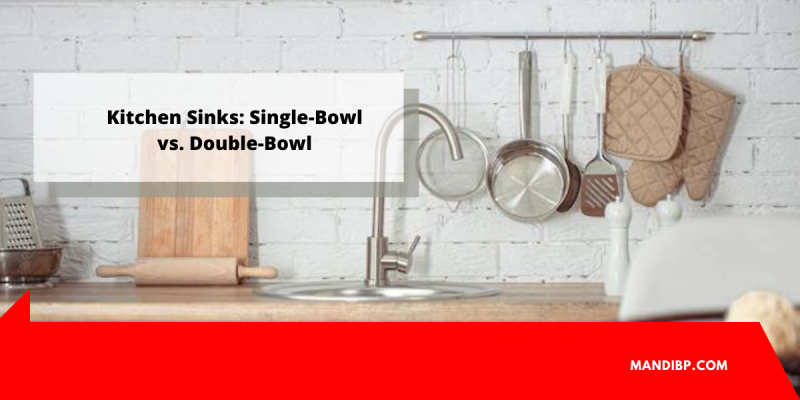What exactly is a single-bowl sink?
A single-bowl sink has one basin, which is generally big, with no dividers. Buttrick believes the single-bowl sink is having a moment: “We notice a shift away from the double-bowl sink,” he says. “Our clientele prefer one huge bowl; in fact, we are not installing any double-bowl sinks.”

What exactly is a double-bowl sink?
A double-bowl (or divided) sink contains two basins in one unit, which are normally separated by a divider. Traditionally, both sinks would have the same size, with one bowl filled with hot soapy water and the other with clear water for rinsing; however, double-bowl sinks come in a range of sizes and configurations: Manufacturers are now producing twin units with one sink that is half the size of the main one, allowing the unit to take up less counter space as a whole. Sometimes the smaller sink is also shallower.
What are the advantages of getting a single-bowl sink?
- They frequently fit better in tighter quarters.
Single-bowl sinks have an advantage over double-bowl designs, especially in kitchens with limited counter space.
- They have more space for cleaning big pots and pans.
Buttrick says he exclusively installs single-bowl sinks these days because of the need for more sink space, rather than a shortage of counter space: “With a huge single-bowl sink, it’s simple to clean that giant roasting pan, wok, or lobster pot,” he adds—no divider to bump against. Easy dishwashing is certainly welcomed by any clean-as-you-go cook. If you don’t clean as you go, a large, deep single sink is a fantastic spot to keep dirty pots and dishes to keep your kitchen looking neat.
What are the disadvantages of a single-bowl sink?
- It is impossible to divide and conquer.
If you only have one sink and it’s not very huge, the space might become congested when people are assisting you in the kitchen—or simply attempting to grab a drink of water, clean hands, or fill a vase for flowers. And if you hand-wash dishes (for example, if you don’t have a dishwasher or possess fragile vintage china), it’s more difficult to wash, rinse, and drain them in a single-bowl sink. A built-in drainboard, on the other hand, can be useful.
- They are not as easily disposed of.
Another disadvantage is that when your sink is full of water or filthy dishes, your trash disposal, if you have one, is inaccessible (whereas it would be if you had one bowl for the disposal and one for dishes).
What are the advantages of getting a double-bowl sink?
“In a perfect world, a double-bowl sink with good-sized bowls is a beautiful thing,” Williams adds. True, having two sinks side by side may be pretty luxurious.
- It’s perfect for hand-washing dishes.
It’s useful if you like to hand-wash your dishes (as some people do). Since dishwashers took over, double-bowl sinks are no longer often used. It’s also typical to maintain a rack in the second sink to allow washed things to air dry; some double-bowl models include an integrated cutting board that fits over one sink for more work area.
- You may keep dirty dishes separate from food preparation.
You may stack dirty dishes and utensils in one basin while cooking a dinner and use the other for vegetable prep in a double-bowl sink.
- There is always a waste disposal available.
The trash disposal is usually positioned in the smaller sink so that it is accessible when the larger sink is full of water or unclean dishes.
What are the disadvantages of a double-bowl sink?
- The size and profile might be inconvenient.
For starters, one disadvantage is the quantity of counter space required. A double-bowl unit can be 40 or even 48 inches long (a triple-bowl unit can go as long as 60 inches), and remember that additional counter space is required on both sides of the sinks for storing unwashed and clean objects. That’s a lot of space in a little kitchen. “Here in San Francisco, folks do the math and realize they don’t have enough counter space to give away for two good-size bowls,” Williams adds.
- It takes up valuable under-counter storage space.
Another disadvantage is that you lose under-counter storage space since a sink base cabinet lacks shelves and drawers. (Not to mention that waste disposal consumes significant room.)
- It may, ironically, mean less space for bulky objects to be washed.
Finally, consider sink size, especially if one bowl is smaller than the other. “It’s just inconvenient to have a second dish that’s not very big,” Williams explains. “It makes washing large goods like roasting pans difficult.” Some double-bowl systems include a lower inner barrier that makes it simpler to clean large pots.
For more information about kitchen sink malaysia, please visit https://www.mandibp.com/


